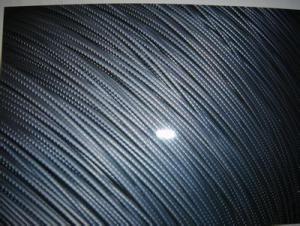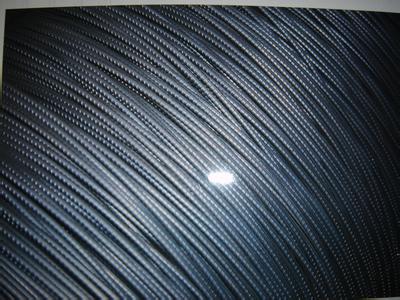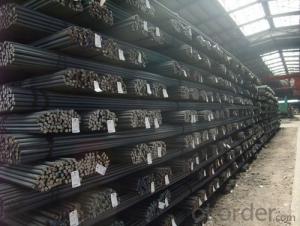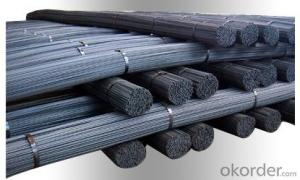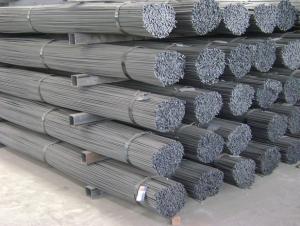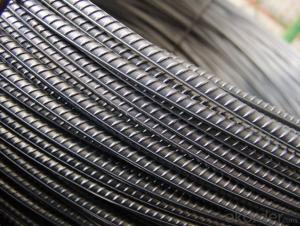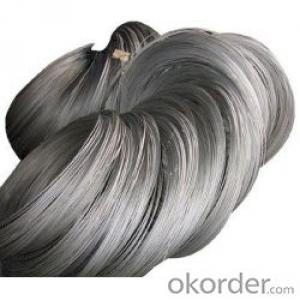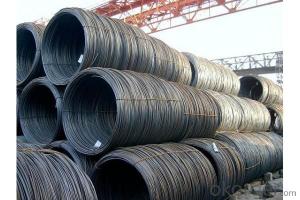Five Point Five mm Cold Rolled Steel Rebars in coils
- Loading Port:
- China Main Port
- Payment Terms:
- TT OR LC
- Min Order Qty:
- -
- Supply Capability:
- -
OKorder Service Pledge
OKorder Financial Service
You Might Also Like
Specifications of Steel Rebar:
Name | Cold Rolled Steel Rebar | | |
Diameter | 5mm, 5.5mm, 6mm, 6.5mm, 7mm, 8mm, 9mm, 10mm, 11mm, 12mm, | | |
| | |||
Length | 6M, 9M, 12M or as required | | |
Price | Keep lower operating costs so as to offer competitive price for our clients | | |
Label | to be specified by customer, generally, each bundle has1-2 labels | | |
Application | Building, construction | | |
Invoicing | Actual or Theoretical Weight Basis as buyer’s request. | ||
Theoretical weight and section area of each diameter as below for your information:
Diameter(mm) | Section area (mm²) | Mass(kg/m) | ||
5.5 | 23.7 | 0.186 | ||
Packaging & Delivery of Steel Rebar:
Packaging Detail: products are packed in bundle and then shipped by container or bulk vessel, deformed bar is usually naked strapping delivery, when storing, please pay attention to moisture proof. The performance of rust will produce adverse effect.
Each bundle weight: 2-3MT, or as required
Payment terms: TT payment in advance or Irrevocable LC at sight.
Trade terms :FOB, CFR, CIF
Delivery Detail: within 45 days after received advanced payment or LC.
- Q: How are steel rebars bent or shaped to fit specific construction requirements?
- Steel rebars are commonly bent or shaped to fit specific construction requirements through a process known as rebar bending. This process involves the use of specialized machines that apply force to the rebar, causing it to bend or shape according to the desired specifications. There are different methods used to bend steel rebars, depending on the complexity of the required shape. For simpler bends, such as 90-degree angles, manual bending tools like hammers or manual rebar benders can be used. These tools allow construction workers to manually apply force and shape the rebar by hand. However, for more complex shapes or larger quantities of rebars, mechanical rebar benders are often employed. These machines are equipped with bending dies and rollers that can bend the steel rebar with greater precision and efficiency. They can be manually operated or powered by hydraulics or electricity, depending on the size and requirement of the construction project. Computer Numerical Control (CNC) machines are also utilized in some cases, especially for projects with intricate or customized rebar shapes. These machines are programmed to automatically bend the rebars to the desired angles and shapes, ensuring high precision and accuracy in the construction process. It is worth noting that rebar bending is not limited to simple bends or shapes. In some cases, rebars need to be curved or spiraled to fit specific architectural or structural requirements. This process involves the use of specialized bending machines that can apply gradual and controlled force to the rebar, resulting in smooth curves or spirals. Overall, the process of bending or shaping steel rebars to fit specific construction requirements involves the use of manual tools, mechanical benders, or CNC machines. These methods ensure that the rebars are precisely bent or shaped according to the design specifications, allowing for the efficient and accurate construction of reinforced concrete structures.
- Q: How do steel rebars contribute to the overall sustainability of a project?
- Steel rebars contribute to the overall sustainability of a project by enhancing the durability and strength of reinforced concrete structures. This allows for longer lifespan, reduced maintenance needs, and decreased material waste over time. Additionally, steel rebars can be recycled, reducing the demand for new steel production and minimizing the environmental impact of the project.
- Q: What is the cost of steel rebars?
- Different factors, including steel grade, market conditions, and location, can cause the price of steel rebars to vary. Generally, the price ranges from $500 to $800 per metric ton. Nevertheless, it is crucial to consider that prices can change due to factors like supply and demand, raw material expenses, and any taxes or tariffs imposed on steel imports. To obtain the most accurate and current pricing information, it is advisable to reach out to local suppliers or consult market reports.
- Q: How do steel rebars perform in extreme weather conditions?
- Steel rebars are highly durable and perform exceptionally well in extreme weather conditions. They can withstand high temperatures, intense cold, and exposure to moisture without compromising their strength and integrity. The robust nature of steel rebars makes them an ideal choice for reinforcing concrete structures in areas prone to hurricanes, earthquakes, and other severe weather events.
- Q: What is the resistance of steel rebars against acid attacks?
- Due to the protective layer of rust that forms on their surface, steel rebars exhibit a high resistance to acid attacks. This layer, commonly known as iron oxide, acts as a barrier, effectively preventing direct contact and corrosion between the steel and the acid. Furthermore, the steel rebars' resistance to acid attacks is enhanced by their high carbon content, which results in the formation of a protective film that provides additional shielding from acid damage. However, it is important to bear in mind that extended exposure to highly concentrated or corrosive acids may still cause some degree of corrosion, although at a slower pace compared to other metals. Therefore, it is recommended to carefully choose the appropriate grade of steel rebar and implement supplementary protective measures, such as coatings or concrete coverings, in order to ensure optimal resistance against acid attacks in specific applications.
- Q: Can steel rebars be used in hotel construction?
- Yes, steel rebars can be used in hotel construction. Steel rebars are commonly used as reinforcement in concrete structures, including hotel buildings, to enhance their strength and durability. They provide necessary support to the concrete, ensuring the structural integrity of the hotel during its lifespan.
- Q: Are steel rebars suitable for use in road construction?
- Certainly, steel rebars prove to be a suitable choice for road construction. These reinforcing bars, widely recognized as steel rebars, find common application in road construction endeavors owing to their exceptional strength and durability. By reinforcing concrete and improving the road's structural integrity, they enable it to endure heavy loads and traffic for extended periods. Steel rebars exhibit remarkable resistance to corrosion and boast a high tensile strength, enabling them to effectively absorb and distribute the stress and strain generated by vehicles traversing the road's surface. Furthermore, steel rebars offer flexibility and prevent concrete from cracking, rendering them an indispensable element in road construction, ensuring the creation of long-lasting and secure roads.
- Q: Can steel rebars be used in railway and metro construction?
- Yes, steel rebars can be used in railway and metro construction. They are commonly used to reinforce the concrete structures in these types of projects, providing strength and durability to the infrastructure.
- Q: Can steel rebars be used in the construction of shopping complexes?
- Shopping complexes can indeed utilize steel rebars in their construction. These rebars are frequently employed as reinforcement in concrete structures, including shopping complexes, owing to their exceptional strength and capacity to bear heavy loads. By providing structural integrity, they bolster the overall robustness and longevity of the building. Furthermore, steel rebars possess corrosion resistance, a vital attribute for structures such as shopping complexes that face diverse weather conditions and extensive foot traffic. Additionally, the utilization of steel rebars permits flexibility in design and construction, empowering architects and engineers to fashion intricate and distinctive structures. In summary, steel rebars are a dependable and extensively utilized material for reinforcing concrete in the construction of shopping complexes.
- Q: Can steel rebars be used in high-security facility construction?
- Yes, steel rebars can be used in high-security facility construction. Steel rebars provide enhanced strength and durability, making them suitable for reinforcing structures in high-security facilities where robustness and resistance against external threats are crucial.
Send your message to us
Five Point Five mm Cold Rolled Steel Rebars in coils
- Loading Port:
- China Main Port
- Payment Terms:
- TT OR LC
- Min Order Qty:
- -
- Supply Capability:
- -
OKorder Service Pledge
OKorder Financial Service
Similar products
Hot products
Hot Searches
Related keywords
